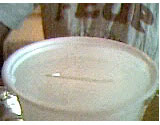


|
The needle that floats
Science at Home |
||
|
Materials
|
Compounds
|
Videos: download.avi (95 KB)
Pictures: 
|
|
Procedure
1. Pour distilled water in a glass [1] up to 3/4 of its total capacity. (the water should be distilled to have a low amount of ions and other impurities, that can affect the superficial tension) 2. Pour the same amount of distilled water in another glass [2] and dissolve in it the maximum amount of sodium chloride (kitchen salt). (the maximum amount can be noticed when the salt begins to precipitate in the glass bottom) 3. Now, let's begin with the first needle. Place it in the surface of the water without any finger contact. (you can use tweezers to place the needle. You will verify that the needle will lay more easily in the water surface with dissolved salt. You shouldn't touch the needle because our fingers have always impurities, affecting the superficial tension) 4. Finally, the needle [2] should be dipped in oil before placing it in the water surface. (you will verify that for both glasses, the needle floating will be much easier) |
||
|
Why?
The needle doesn't sinks in water due to the superficial tension in the interface that separates water from air. The superficial tension was discussed in the experiment Overliquid in a glass. As well as the river insects that move freely in the water surface, the needle doesn't sinks because the superficial tension is capable to bear its low weight. It is evident that if we had the same mass in the sphere form, this would dive because the superficial tension would act in a very small perimeter. We need to have in account also the impulse that the water exercises in the needle. That is, when the needle is in equilibrium the sum of the forces acting in it is null. The sum of the impulse and vertical component of the tension superficial times the perimeter of the needle is equal to its weight. In the final experiment, the oil is introduced because it is hydrophobic. Diving the needle in the oil will make its surface more hydrophobic and it will facilitate the needle equilibrium in the water interface. Sometimes it is not necessary to add oil, because the fat of our hands is enough to turn the needle flotation easier. Now you know how to float a metal object in water!
|
||
No part of this website can be reproduced without previous authorization. Please inform me if there is any problem with the website. |